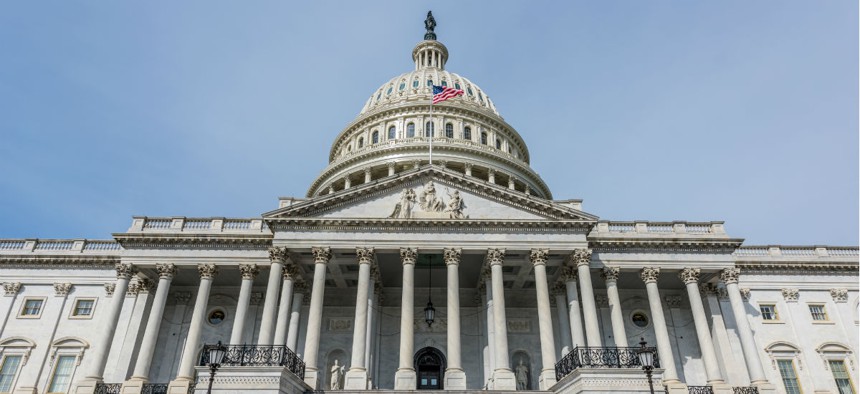Senate Seeks Much Smaller Spending Cuts Than Trump and the House, at Some Agencies
Republicans approve some separation incentives but look to block others.
Senate Republicans are poised to fund several key agencies at significantly higher levels than the Trump administration requested, though Democrats are still decrying what they see as overly harsh reductions.
The cuts also are less severe than those approved by the House in September, setting the framework for the forthcoming negotiations over how to fund agencies for the remainder of fiscal 2018. At the Environmental Protection Agency, for example, the Senate Appropriations Committee proposed cuts of about $150 million compared to fiscal 2017 spending levels. That pales in comparison to the $2.6 billion cut the administration had requested and adds $378 million to what the House has suggested.
Like the House bill, the Senate measure includes language supporting EPA budgeting for buyouts and early retirement incentives to reduce its workforce. Senators rejected administration proposals to cut staffing at the agency’s inspector general office, however.
At the Interior Department, a Senate measure unveiled on Monday would cut spending from current levels by just 1 percent. The reduction would be $370 million less severe than the House proposal and $470 million less than the administration’s request. While the House bill also included language supporting separation incentives at Interior, such provisions were not included in the Senate bill. At components such as the National Park Service, the Senate actually proactively spoke out against any workforce cuts.
“Proposed reductions to both the seasonal and permanent workforce would also have an immediate impact on park operations,” Senate Republicans on the Appropriations Committee wrote. “Such proposals do not serve the public well particularly at this time of record National Park Service visitation.”
The committee pitched cuts of about $110 million from current spending levels to the Internal Revenue Service, which roughly equals the proposal from the House but is less than half the requested reductions from the Trump administration. The IRS will acutely feel any cuts in the remainder of the fiscal year, as the agency has seen its funding slashed by 10 percent since 2010.
Sen. Chris Coons, D-Del., the top Democrat on the committee's Financial Services and General Government panel, praised his Republican counterparts for boosting proposed IRS funding above the administration’s ask. He and the committee’s ranking member, Sen. Patrick Leahy, D-Vt., still said the spending level was insufficient at IRS and other regulatory agencies such as the Consumer Financial Protection Bureau.
Leahy more aggressively opposed the appropriations bill setting funding for Interior and EPA, saying he was “deeply disappointed” that it “bowed to the anti-science know-nothingism of President Trump by slashing environmental programs and denying the reality of climate change.”
Like the House bill, the Senate measure proposed fully funding the National Endowment for the Arts and the National Endowment for the Humanities, two agencies Trump had slated for elimination. Sen. Tom Udall, D-N.M., praised Republicans for that decision, but criticized the major provisions of the bill.
“I can’t look past the deep and damaging cuts to the EPA budget in this bill that put public health at risk,” Udall said. “And I can't ignore that it takes aim at the laws that protect our environment and our communities.”
Other agencies with governmentwide management responsibilities would take hits under the Senate bills. The Office of Personnel Management would see a slight budget increase, but would receive almost $20 million less than Trump’s request. Democrats slammed what they viewed as inadequate funding for OPM cybersecurity initiatives aimed at better protecting federal employees’ personal information. The General Services Administration would see its Federal Buildings Fund cut by $1 billion, with no money appropriated for new construction. The measure would allocate just $94 million for repairs of existing federal buildings, compared to the $1.4 billion the administration had requested.
The Senate will consider its proposals on a shortened timeline. A continuing resolution currently funding agencies at fiscal 2017 levels is set to expire Dec. 8, though congressional leaders have already said another stopgap measure is likely. Democrats on the appropriations panel derided Republicans for failing to plan any markups on their new spending measures.
As part of the forthcoming negotiations, Congress must reach an agreement to raise the 2011 Budget Control Act spending caps or risk a sequestration. According to multiple reports, lawmakers are currently working on a two-year budget deal to increase spending levels by as much as $200 billion. Congress struck similar agreements in both 2013 and 2015. Democrats have insisted that any such deal must raise spending equally for defense and non-defense agencies.
“We cannot responsibly fund the government if we do not reach a new bipartisan budget deal that lifts the reckless budget caps,” Leahy said. “The consequences of sequestration have been devastating, and we must reach a bipartisan solution.”
Other outstanding issues, such as health insurance subsidies, Trump’s proposed wall along the U.S.-Mexico border and the status of certain undocumented immigrants, could also upend negotiations as a shutdown draws closer.








